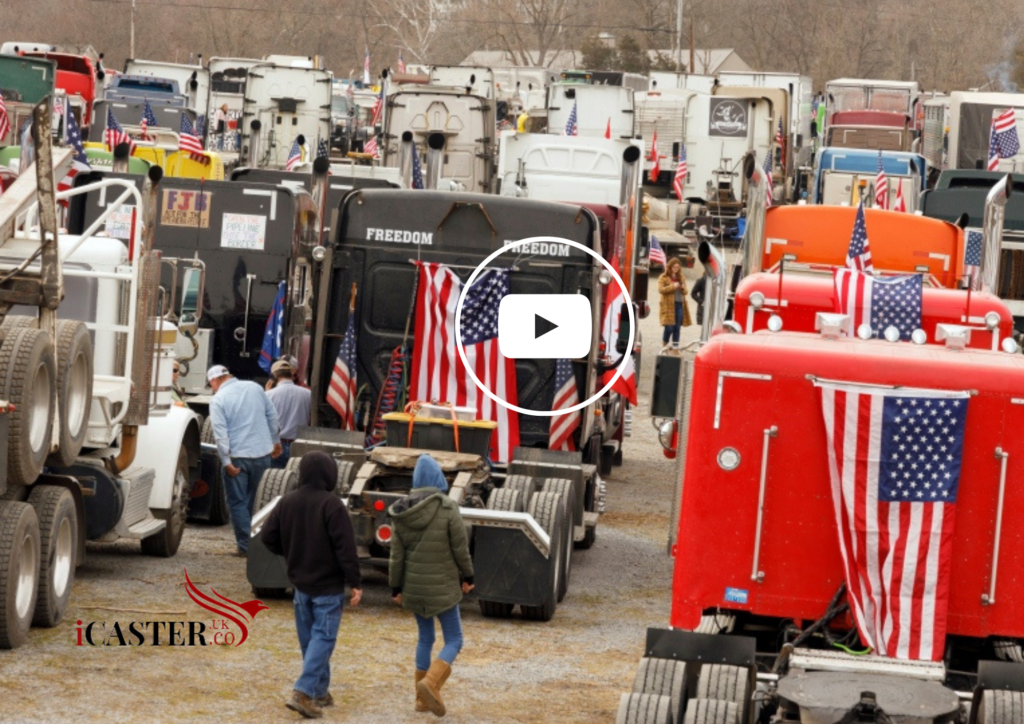Next week, a gathering of truckers who are passionate about Jesus will unite at the southern border, aiming to counter what they perceive as a migrant “invasion.” This unfolds against the backdrop of a Texas federal standoff over the razor wire installed along the Rio Grande in Eagle Pass.
Titled the “Take Our Border Back Convoy” and promoted by far-right media, the event is pitched as a “peaceful assembly” comprising individuals from law enforcement, military backgrounds, ranchers, bikers, business owners, and even “Mama Bears.”
According to observations by Media Matters, certain organizers associated with the movement include individuals linked to election denial, anti-vaccine sentiments, and QAnon conspiracy theories.
Kim Yeater, a key figure in the movement, recently described the convoy as a “god movement” during an interview with a Christian podcaster. She expressed the belief that this movement could thwart a potential “Trojan horse” in the 2024 election.
Yeater, known for promoting unfounded claims about the 2020 election, emphasized the need for Americans to reclaim their border and shed light on what she perceives as underlying issues. She asserted, “The Bible says to bring everything into the light. We need to hold our elected officials accountable to closing the border and sending the illegal immigrants home back to their countries.”
Yeater added a spiritual perspective, stating, “The battle is the Lord’s. We must step in as victors in Christ. We are not victims of the enemy.”
Co-organizer Mark Anthony shared a similar sentiment in an interview with a right-wing show, expressing a belief in the presence of the Spirit of God within the movement. He highlighted the assembly as a manifestation of divine inspiration, stating, “He is here, He is present, and this is all about Him.”
As of Friday evening, the convoy, having garnered over $54,000, is scheduled to embark on January 29, converging at three different locations: Eagle Pass, Yuma, Arizona, and San Ysidro, California.
The promotional video for this convoy begins with a striking “WARNING INVASION ALERT,” accompanied by outdoor sirens and night-vision footage. Posing the question, “When does it end?” the video transitions to scenes of flag-waving truckers.
Expressing concern, Don Haider-Markel, a political science professor at the University of Kansas, highlights two apprehensions: the potential for the demonstration to be a money-driven venture and the risk of attracting armed extremists and vigilante groups.
He underscores that the video’s rhetoric, coupled with former President Trump’s remarks branding immigrants as “poisoning the blood of our country,” could potentially ignite a volatile situation.
“They‘re essentially setting up a confrontation: Our approach is not just addressing the issue but confronting individual migrants attempting to cross the border. The sense of threat and the response to it are heightened,” Haider-Markel remarked.
“You’re getting people worked up into a frenzy over this, and the idea that it’s going to be entirely peaceful with no criminal activity, nothing adverse happening, to me, seems really misguided.”
He added that labeling the event as a “peaceful assembly” on the flyer is likely a tactic to minimize liability.
The truckers are heading to Texas amidst escalating tensions.

This week, the U.S. Supreme Court granted Border Patrol agents the authority to remove concertina wire that Governor Greg Abbott had instructed the Texas National Guard to install to curb a surge in migrant crossings at the U.S.-Mexico border.
Exploiting a loophole in the Supreme Court’s ruling, Abbott plans to continue laying razor wire even as the federal government removes it.
The Biden administration argued that the wire hindered federal agents from monitoring the border and caused injuries to some individuals attempting to enter the country. Earlier this month, a migrant woman and two children drowned in the Rio Grande after the Texas National Guard blocked federal agents from accessing the area near Shelby Park in Eagle Pass.
On Thursday, Newsmax aired a troubling interview that fueled concerns of a civil war, with the host speculating about a “force-on-force conflict” between Texas and the federal government.
On Friday, Texas Rep. Keith Self, a Republican, appeared on Fox Business and suggested that as many as 700,000 trucks could gather at the border. Self, a scheduled speaker at the Eagle Pass stop, mentioned that some participants were part of the trucker convoy that traveled from California to Washington, D.C. in 2022. (As reported by The Daily Beast, that protest, known as the “People’s Convoy,” aimed to oppose pandemic restrictions.)
Convoy organizer Pete Chambers, who identifies as a Green Beret and doctor, shared with InfoWars that he believes “globalists” are manipulating migrants as pawns on a global chessboard to destabilize the country. It’s worth noting that the term “globalist” has roots as an anti-Semitic slur and is embraced by far-right and conspiracy circles.
During the discussion with host Alex Jones, Chambers acknowledged his group’s involvement in what he described as domestic internal defense, a departure from their traditional focus on foreign internal defense and unconventional warfare. He drew parallels with U.S. war tactics used against ISIS in Syria, emphasizing the importance of locating, fixing, and ultimately neutralizing threats.
Chambers mentioned that his group lacks the authority to “finish” and specified their role in finding and fixing the location of perceived threats. He emphasized collaboration with constitutionally sound law enforcement but raised concerns about some authorities being compromised.
Haider-Markel points out that for some participants, the convoy serves as a platform to engage in a form of cosplay reminiscent of their activities during state capital protests over COVID restrictions. The genesis of this lies in the idea that a gathering can be orchestrated to express love for Jesus Christ while showcasing firearms, reflecting participants’ desire to act out their identities and beliefs.
Jon Lewis, a research fellow at George Washington University’s Program on Extremism, suggests that while the convoy may involve a small and not entirely proficient group of conspiracy theorists, it signals a deeper issue in American discourse.
He highlights the convoy’s Christian nationalist undertones and its connection to the Great Replacement Theory, wherein organizers propagate narratives about shadowy globalists replacing the white population with non-white immigrants—a theme observed in Trump and MAGA Republican circles.
Lewis emphasizes the mainstream acceptance of such white supremacist narratives, reflecting how rapidly and easily they permeate a broad spectrum of individuals. He notes that many conspiracy-minded actors and movements seek opportunities to gain attention and escalate situations, engaging in brinkmanship to remain relevant or even instigate a standoff, acting as catalysts for escalation.


